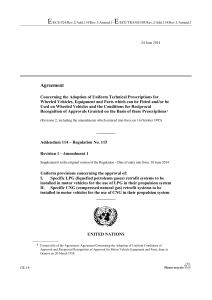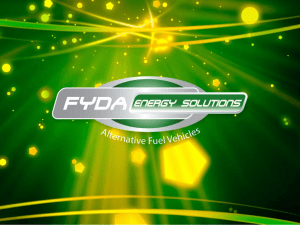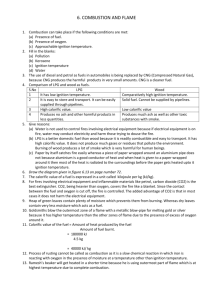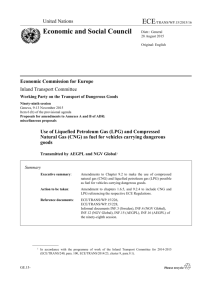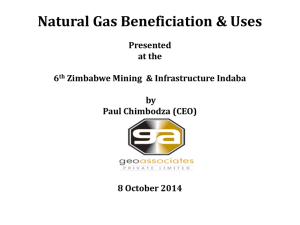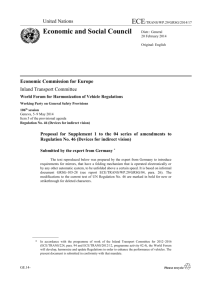United Nations
advertisement
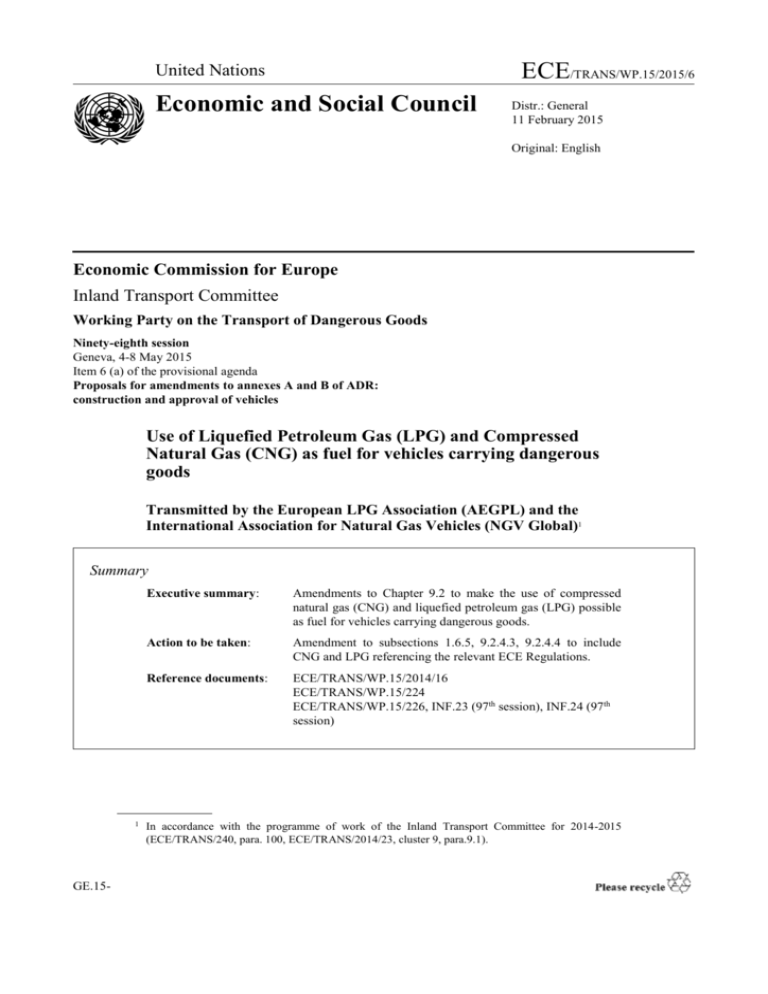
ECE/TRANS/WP.15/2015/6 United Nations Economic and Social Council Distr.: General 11 February 2015 Original: English Economic Commission for Europe Inland Transport Committee Working Party on the Transport of Dangerous Goods Ninety-eighth session Geneva, 4-8 May 2015 Item 6 (a) of the provisional agenda Proposals for amendments to annexes A and B of ADR: construction and approval of vehicles Use of Liquefied Petroleum Gas (LPG) and Compressed Natural Gas (CNG) as fuel for vehicles carrying dangerous goods Transmitted by the European LPG Association (AEGPL) and the International Association for Natural Gas Vehicles (NGV Global)1 Summary 1 GE.15- Executive summary: Amendments to Chapter 9.2 to make the use of compressed natural gas (CNG) and liquefied petroleum gas (LPG) possible as fuel for vehicles carrying dangerous goods. Action to be taken: Amendment to subsections 1.6.5, 9.2.4.3, 9.2.4.4 to include CNG and LPG referencing the relevant ECE Regulations. Reference documents: ECE/TRANS/WP.15/2014/16 ECE/TRANS/WP.15/224 ECE/TRANS/WP.15/226, INF.23 (97th session), INF.24 (97th session) In accordance with the programme of work of the Inland Transport Committee for 2014-2015 (ECE/TRANS/240, para. 100, ECE/TRANS/2014/23, cluster 9, para.9.1). ECE/TRANS/WP.15/2015/6 Introduction 1. The amending of ADR Regulations (especially Chapter 9.2) to include provisions for vehicles powered by gaseous fuels has prompted discussions for which AEGPL and NGV Global were invited to provide further justification. Based on working document ECE/TRANS/WP.15/2014/16 both organisations wish to specify the suggested amendments and address further questions raised by some delegations during the ninetyseventh session (November 2014). 2. The suggested amendments are based on proven reliable technology. There are more than 25 million vehicles worldwide running on liquefied petroleum gas (LPG) and over 21 million natural gas vehicles (NGVs), (including nearly 1.5 million heavy duty trucks and buses). Heavier vehicles fitted with compression ignition engines have been converted to operate on diesel and gaseous fuels simultaneously (referred to as dual-fuel vehicles). The United Nations regulations for LPG and compressed natural gas (CNG) components and their use on road vehicles (ECE Regulations No. 67-01 and No.110 respectively) have been in force for many years. Regulations for dual-fuel vehicles have recently been included in ECE Regulation No. 49 (heavy duty vehicles) and came into force in July 2014. LPG and natural gas (CNG and LNG) are fully legitimized fuels and fuel systems governed within a substantial body of existing United Nations regulations as well as standards and regulations adopted by many nations worldwide. 3. Concurrent with the philosophy of creating a harmonized and consistent regulatory approach to LPG and CNG, AEGPL and NGV Global advocate the specification of these market-proven fuels, fuel systems and vehicles within ADR with reference to the applicable ECE-Regulations (Nos. 67-01 and 110). Both organizations, therefore, support the notion that additional requirements regarding the specifics of dangerous goods transport that are not yet addressed by WP.29 should be included in ADR (as per Proposal 2 below). This combination of ECE-Regulations (Nos. 67-01 and 110) and the aforementioned additional requirement will provide sufficient safety provisions to justify the use of CNG and LPG as fuels for heavy goods vehicles carrying dangerous goods. AEGPL and NGV Global propose to amend the wording in ADR accordingly. I. Properties of gaseous fuels 4. Both LPG and CNG, gaseous in their natural state under normal atmospheric conditions, exhibit good mixing qualities. Under ventilated conditions (esp. outdoors) dissipation is quick enough for this risk to be negligible in practice. 5. Both CNG and LPG are non-oxidant, non-corrosive and do not react with other chemicals. 6. Both CNG and LPG are non-toxic and apart from displacing air (risk of asphyxiation) have no harmful effects on human beings. 7. Both CNG and LPG are dangerous goods, flammable, compressed and low pressure liquefied gases, Class 2 Classification codes 1F and 2F respectively. They have been assigned the following UN Nos.: 1971 for CNG and 1965 for LPG. 8. Under prolonged exposure (several hours) LPG in its liquid phase can act as a solvent for certain materials. 9. Please refer to the accompanying technical documents that present the physical properties, safety aspects and potential hazards in more detail (Informal documents INF.23 and INF.24 submitted at the 97th session). 2 ECE/TRANS/WP.15/2015/6 II. Gaseous fuel systems including fuel containers 10. The technical requirements in the existing regulations (ECE Regulations 67-01 and 110) account for the differences of the respective fuels to provide levels of safety comparable to that of liquid fuels. 11. Fuel containers for CNG and LPG are required to withstand the elevated pressures needed to store the fuels, thus inherently resist much higher puncture loads than tanks for liquid fuels. 12. The attachment of the fuel containers for CNG and LPG to the vehicle frame is required to withstand severe mechanical stresses. The fastenings are required to absorb accelerations exceeding 5.5 g. 13. Fuel containers for CNG and LPG are required to be equipped with automatically closing valves that close off the fuel flow from the container to the engine system in case of an accident when the engine stops and prevents fuel from leaking through ruptured fuel lines. 14. As no significant volume of fuel is contained in the fuel lines the release of gas is limited, considerably lowering the risk of a truck fire. As such, CNG and LPG fuel systems are at least equally robust as diesel fuel systems and are unlikely to result in substantial fuel leakage. 15. Fuel containers for CNG and LPG are designed with integral fire protection. The suitability of each fuel storage system design is certified through bon-fire tests in which the container filled to its rated capacity is exposed to a uniform fire source completely engulfing it in flames. The pressure relief valve gradually releases the pressure in a controlled manner, thereby preventing the container from bursting until no fuel is left. 16. The electrical equipment in CNG and LPG fuel systems generally is not required to comply with the provisions in their respective regulations, thus, the electrical equipment may need modification and approval according to the provisions given in section 9.2.2. 17. More in-depth evaluation of the potential hazards and technical means by which they are addressed can be found in the respective informal documents provided for CNG and LPG that support this working document (INF.23 and INF.24 submitted at the 97th session). III. Proposals 18. The following proposed amendments are based on the new text of ADR 2017 as agreed in the May 2014 meeting (96th session) appearing in ECE/TRANS/WP.15/224 also taking into account the comments of the delegations given to AEGPL and NGV Global after the 97th session (see ECE/TRANS/WP.15/226). 19. Deletions are shown as stricken through and new text is shown in italics and underlined. A. Proposal 1 20. Amend transitional measure 1.6.5.17 of ADR adopted at the 96th session (ECE/TRANS/224, annex II) to read as follows: "1.6.5.17 FL and OX vehicles registered before 1 July 2017, fitted with an LNG, CNG or LPG fuel system, not fully in compliance with the provisions found in ECE Regulations 3 ECE/TRANS/WP.15/2015/6 No. 110 and No. 67-01 respectively, may still be used with the approval of the competent authority of the country of registration, if an equal level of safety can be demonstrated." B. Proposal 2 21. Amend sub-section 9.2.4.3 (as laid down in ECE/TRANS/WP.15/224, annex II) to read as follows: "9.2.4.3 Fuel tanks and fuel containers The fuel tanks and fuel containers supplying the engine of the vehicle shall meet the following requirements: (a) In the event of any leakage, under the provision that the vehicle can still be considered upright6, the liquid fuel or the liquid phase of a gaseous fuel shall drain to the ground and not come into contact with hot parts of the vehicle or of the load.; (b) Fuel tanks for liquid fuels shall meet the requirements of ECE Regulation No. 34;, fuel containers for LNG and for CNG shall meet the relevant requirements of ECE Regulation No. 1107; fuel containers for LPG shall meet the requirements of ECE Regulation No. 67-018. (c) The discharge opening(s) of pressure relief devices and/or pressure relief valves shall be directed away from air intakes, fuel tanks, hot parts of the vehicle or the load. ---6 inclined no more than 23 ° to either side according to ECE Regulation No. 111 (Uniform provisions concerning the approval of tank vehicles of categories N and O with regard to rollover stability) 7 ECE Regulation No. 110 (Uniform provisions concerning the approval of: I. Specific components of motor vehicles using compressed natural gas (CNG) and/or liquefied natural gas (LNG) in their propulsion systems; II. Vehicles with regard to the installation of specific components of an approved type for the use of compressed natural gas (CNG) and/or liquefied natural gas (LNG) in their propulsion system). 8 ECE Regulation No. 67, as amended by the 01 series of amendments (Uniform provisions concerning the approval of: I. Specific equipment of vehicles of category M and N using liquefied petroleum gases in their propulsion system II. Vehicles of category M and N fitted with specific equipment for the use of liquefied petroleum gases in their propulsion system with regard to the installation of such equipment) C. Proposal 3 22. Amend sub-section 9.2.4.4 (as laid down in ECE/TRANS/WP.15/224, annex II) to read: "9.2.4.4 Engine 4 ECE/TRANS/WP.15/2015/6 The engine propelling the vehicle shall be so equipped and situated to avoid any danger to the load through heating or ignition. The use of compressed natural gas (CNG) or liquefied natural gas (LNG) as fuel shall be permitted only if the specific components for CNG and LNG are approved according to ECE Regulation No. 1107 and their installation on the vehicle complies with the technical requirements of ECE Regulation No. 1107. The use of liquefied petroleum gas (LPG) as fuel shall be permitted only if the specific components for LPG are approved according to ECE Regulation No. 67-018 and their installation on the vehicle complies with the technical requirements of ECE Regulation No. 67-018. In the case of EX/II and EX/III vehicles the engine shall be of compression-ignition construction using only fuels with a flashpoint above 55 °C. ---6 inclined no more than 23° to either side according to ECE Regulation No. 111 (Uniform provisions concerning the approval of tank vehicles of categories N and O with regard to rollover stability) 7 ECE Regulation No. 110 (Uniform provisions concerning the approval of: I. Specific components of motor vehicles using compressed natural gas (CNG) and/or liquefied natural gas (LNG) in their propulsion systems; II. Vehicles with regard to the installation of specific components of an approved type for the use of compressed natural gas (CNG) and/or liquefied natural gas (LNG) in their propulsion system). 8 ECE Regulation No. 67, as amended by the 01 series of amendments, (Uniform provisions concerning the approval of: I. Specific equipment of vehicles of category M and N using liquefied petroleum gases in their propulsion system II. Vehicles of category M and N fitted with specific equipment for the use of liquefied petroleum gases in their propulsion system with regard to the installation of such equipment) Renumber existing footnotes accordingly. III. Justification for proposals A. Proposal 1 23. Vehicles using gaseous fuels (LNG, CNG and LPG) are being used for the transport of dangerous goods by Contracting Parties where they have been approved for service interpreting the current rules of ADR by the respective competent authorities. As such, transitional measures are necessary to enable continued operation of these gaseous fuelled vehicles in accordance with their current approvals. B. Proposal 2 9.2.4.3 (a), (b) and (c) 24. The wording now used also addresses the initial intention to regulate general behaviour of the fuels in (a), and technical requirements for the tank in (b) adding (c) for requirements for further equipment related to the tank. 5 ECE/TRANS/WP.15/2015/6 25. The introduction of the term “normal operating conditions” has caused some confusion, therefore, ECE Regulation No. 111 is referenced and a footnote is added to specify the angle. 26. The reference to liquid leakage was reintroduced in order to more clearly distinguish the behaviour of liquid fuels and those gaseous fuels that also can be in ‘liquid phase.’ Dousing the load with a liquid fuel will have a more intense effect than a gaseous fuel transitioning from its liquid to gaseous phase that might have brief contact with the load if, for example, air turbulence (wind) happens to cause some contact with the load as the gaseous fuel is dissipating into atmosphere. As such, this change seems justified in order to clarify differences in liquid and gaseous fuels that might have ‘contact with the load’ in the event of an accident involving a fuel leak or spill. 27. Gaseous fuels cool when decompressed (Joule-Thomson-effect). Natural gas will cool to about -20 °C but only for a very short amount of time as the gas dissipates. This poses no harm to the equipment, all of which is required to be designed to withstand -20 °C in the provisions laid down in ADR. 28. LPG, when leaking in liquid phase evaporates quickly and cools in the process. The final temperature of the liquid remaining will be defined by the ambient pressure, around 42 °C. As some materials lose ductility at lower temperatures, the chance of brittle fractures may increase. This needs to be taken into account depending on the tank material. In most cases where liquefied gases are filled into the tank, the exact same effect takes place inside the tank so the equipment needs to be designed to withstand the stresses of filling. 29. Fuel containers for gaseous fuels are by regulation tested in fire conditions where a pressure build-up could cause a rupture. The specific regulations (ECE Regulations Nos. 67-01 and 110) contain requirements and tests to type approve fuel containers to prove their fire resistance and safety. The bonfire tests specified in the respective regulations assume an engulfing pool fire. The temperature must reach a set level in a defined period of time in order to ensure the required intensity. The container is required to discharge fuel exclusively through the PRD. The test lasts until the pressure in the container has been reduced to atmospheric. 30. Fuel containers for CNG and LPG are equipped with components that are designed to withstand the heat influx of external fire. No additional measures are required for the transport of dangerous goods as fires with greater intensities than a pool fire will most probably affect the load to a greater extent than the CNG or LPG container and its equipment. A comparable level of safety for fuel containers for LPG, CNG and LNG fulfilling the requirements of ECE Regulations Nos. 67-01 or 110 is assured. 31. In case of a vehicle fire the correct orientation of the pressure relief devices (PRDs) or pressure relief valves (PRVs) shall prevent additional heat influx to the load. Although 9.2.4.3 (a) already requires liquid fuel or the liquid phase of the gaseous fuel not to come into contact “with hot parts of the vehicle or the load”, directing the efflux of the PRD/PRV away from the load may be regarded as an additional level of safety. 9.2.4.4 32. The safety requirements for the fuel systems for LPG and natural gas (CNG and LNG) are elaborated in the respective ECE Regulations No. 67-01 and No. 110. Both ECE Regulations are approved by WP.29. Although these regulations do not take into account the specialties of operation in vehicles for the carriage of dangerous goods, they do address the primary safety requirements such as robustness and resilience against damage. 6 ECE/TRANS/WP.15/2015/6 33. The design of the system depends on the type approval of the components themselves as well as the correct installation on the vehicle, thus guaranteeing trouble-free interaction as well as correct function. IV. General justification Safety: The safety of the gaseous fuel systems has been demonstrated taking into account not only normal operating conditions but also considering the more common incidents like fires (engine, tire and load) or collisions. No additional fire extinguishing equipment is needed. Refuelling equipment for CNG and LPG has been designed to standards accommodating unsupervised operation by the ordinary driving public. The procedures have optimised for safe, quick, uncomplicated refuelling. See specifics in respective informal documents provided for each fuel. Feasibility: Individual Contracting Parties have already approved the operation of gaseous fuelled vehicles and have gathered extensive experience with CNG and LPG. Transporters and heavy goods vehicle manufacturers will have the option to have vehicles of this type approved for the carriage of dangerous goods. Enforceability: In order to guarantee the correct functioning of the system during normal operations as well as the correct functioning of the safety equipment, the installation itself should be approved by the competent authority according to the relevant ECE Regulation as well as the additional provisions made in the text of ADR. 7
